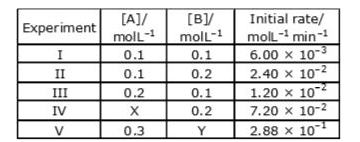For the reaction A+B→C+D. The variation of the concentration of the products withtime is given by the curve:
 Solution in Telugu
Solution in Telugu
X
Y
Z
W
The correct Answer is:B
As the time increases then conc of A and B decreases and Y,C and D increases.
Topper's Solved these Questions
- CHEMICAL KINETICSBOOK - AAKASH SERIESCHAPTER - CHEMICAL KINETICSEXERCISE - LEVEL-II(LECTURE SHEET EXERCISE-II LINKED COMPREHENSION TYPE QUESTIONS)
9 Videos
- CHEMICAL KINETICSBOOK - AAKASH SERIESCHAPTER - CHEMICAL KINETICSEXERCISE - LEVEL-II(LECTURE SHEET EXERCISE-III MATCH THE FOLLOWING QUESTIONS)
3 Videos
- CHEMICAL KINETICSBOOK - AAKASH SERIESCHAPTER - CHEMICAL KINETICSEXERCISE - LEVEL-1 (EXERCISE -II ORDER, MOLECULARITY, HALF LIFE:)
34 Videos
- CHEMICAL KINETCSBOOK - AAKASH SERIESCHAPTER - CHEMICAL KINETCSEXERCISE - EXERCISE - 3.2
45 Videos
- CHEMICAL THERMODYNAMICSBOOK - AAKASH SERIESCHAPTER - CHEMICAL THERMODYNAMICSEXERCISE - Additional Practice Exercise
54 Videos
Similar Questions
A certain endothermic reaction: A→ Product, ΔH=+ve proceeds ina sequence of three elementary steps with the rate constant K1,K2 and K3 and each one having energy of activation E1,E2 and E3 respectively at 25∘C. The observed rate constannt for the reaction is equal to K3√K1K2.
A1,A2 and A3 are Arrhenius parameters respectively.
The observed energy of activation for the reaction is
View SolutionMatch the following columns

View SolutionSucrose decompose in acid solution into glucose and fructose according to the first order rate law, with t12=3.00 hours. What fraction of sample of sucrose remains after 8 hours ?
View SolutionDiscuss on the kinetic spontaneity of a chemical reaction. Is a slow reaction spontaneous? Why?
View SolutionWhich among the following is not an exact differential?
View SolutionFor the reaction, A+Brarr C+D . The variation of the concentration of the products with time is given by the curve:
View SolutionFor the reaction A+B rarr C+D The variation of the concentration of the products is given by the curve
View Solutionअभिक्रिया A+B→C+D के लिये दोनों अभिकारकों की सान्द्रता दोगुना करने पर अभिक्रिया की दर 8 गुना बढ़ जाती है, परन्तु केवल 8 की सान्द्रता दोगुना करने पर अभिक्रिया की दर मात्र दोगुना हो जाती है। वेग नियम है
View SolutionFor a chemical reaction R → P, the variation in the concentration (R) vs time (t) plot is given :

What is the slope of the curve ?
View SolutionFor the reaction, A+B→C+D. The variation of the concentration of the products is given by the curve.

View SolutionThe results given in the below table were obtained during kinetic studies of the following reaction : 2A+BtoC+D X and Y in the given table are respectively :
View SolutionFor a reaction A+B→C+D if the concentration of A is doubled without altering the concentration of B, the rate gets doubled. If the concentration of B is increased by nine times without altering the concentration of A, the rate gets tripled. The order of the reaction is
View Solutionअभिक्रिया A+B→C के लिये आँकड़े हैं

ऊपर दिये गये आँकड़ों से दर नियम है
View Solutionप्राथमिक अभिक्रिया 2A+B→C+D के लिये, आण्विकता है
View SolutionThe results given in the below table were obtained during kinetic studies of the following reaction : 2A+B→C+D

X and Y in the given table are respectively :
View Solution
